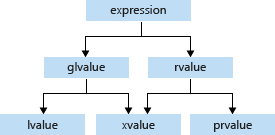Note
Access to this page requires authorization. You can try signing in or changing directories.
Access to this page requires authorization. You can try changing directories.
Every C++ expression has a type, and belongs to a value category. The value categories are the basis for rules that compilers must follow when creating, copying, and moving temporary objects during expression evaluation.
The C++17 standard defines expression value categories as follows:
- A glvalue is an expression whose evaluation determines the identity of an object, bit-field, or function.
- A prvalue is an expression whose evaluation initializes an object or a bit-field, or computes the value of the operand of an operator, as specified by the context in which it appears.
- An xvalue is a glvalue that denotes an object or bit-field whose resources can be reused (usually because it is near the end of its lifetime). Example: Certain kinds of expressions involving rvalue references (8.3.2) yield xvalues, such as a call to a function whose return type is an rvalue reference or a cast to an rvalue reference type.
- An lvalue is a glvalue that isn't an xvalue.
- An rvalue is a prvalue or an xvalue.
The following diagram illustrates the relationships between the categories:

The diagram begins with a box labeled expression, which has two children: glvalue and rvalue. glvalue has two children: lvalue and xvalue. rvalue has two children: prvalue and xvalue; xvalue is also a child of glvalue.
An lvalue has an address that your program can access. Examples of lvalue expressions include variable names, including const variables, array elements, function calls that return an lvalue reference, bit-fields, unions, and class members.
A prvalue expression has no address that is accessible by your program. Examples of prvalue expressions include literals, function calls that return a nonreference type, and temporary objects that are created during expression evaluation but accessible only by the compiler.
An xvalue expression has an address that is no longer accessible by your program but can be used to initialize an rvalue reference, which provides access to the expression. Examples include function calls that return an rvalue reference, and the array subscript, member and pointer to member expressions where the array or object is an rvalue reference.
Example
The following example demonstrates several correct and incorrect usages of lvalues and rvalues:
// lvalues_and_rvalues2.cpp
int main()
{
int i, j, *p;
// Correct usage: the variable i is an lvalue and the literal 7 is a prvalue.
i = 7;
// Incorrect usage: The left operand must be an lvalue (C2106).`j * 4` is a prvalue.
7 = i; // C2106
j * 4 = 7; // C2106
// Correct usage: the dereferenced pointer is an lvalue.
*p = i;
// Correct usage: the conditional operator returns an lvalue.
((i < 3) ? i : j) = 7;
// Incorrect usage: the constant ci is a non-modifiable lvalue (C3892).
const int ci = 7;
ci = 9; // C3892
}
Note
The examples in this topic illustrate correct and incorrect usage when operators are not overloaded. By overloading operators, you can make an expression such as j * 4 an lvalue.
The terms lvalue and rvalue are often used when you refer to object references. For more information about references, see Lvalue Reference Declarator: & and Rvalue Reference Declarator: &&.
See also
Basic Concepts
Lvalue Reference Declarator: &
Rvalue Reference Declarator: &&